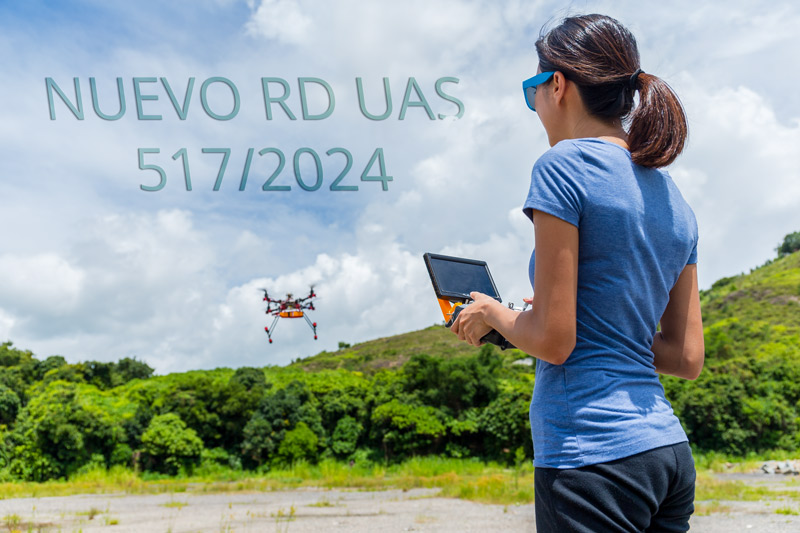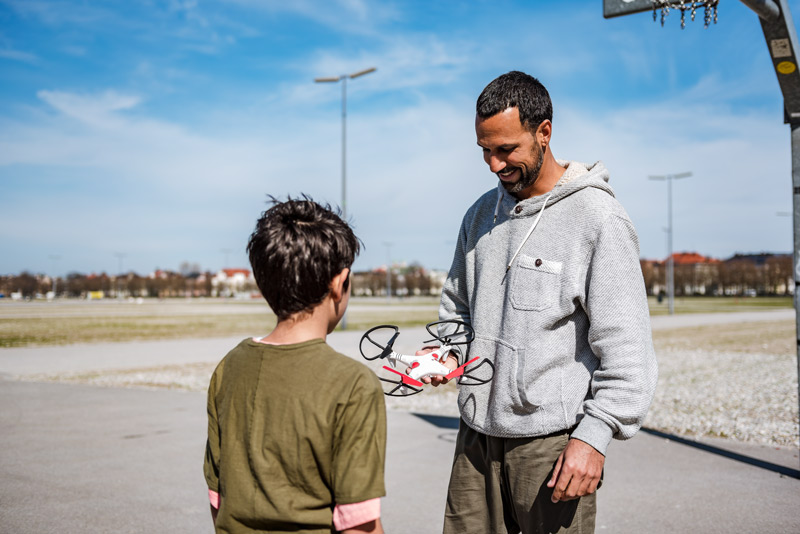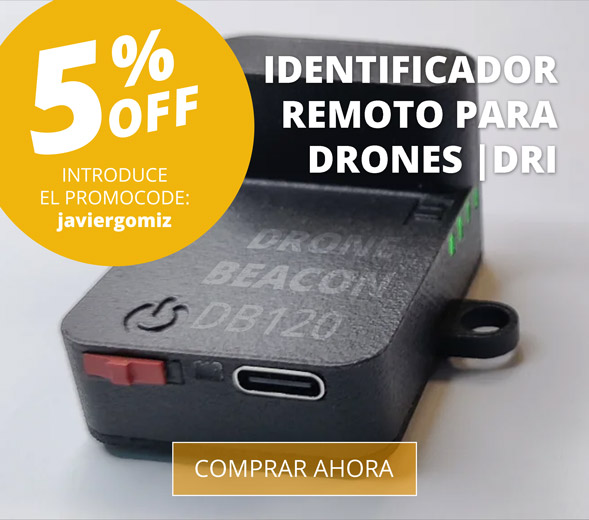The new UAS Royal Decree is presented after several years of waiting for it, with the aim of boosting the drone sector in Spain. Finally, on June 4, 2024, the new legal framework regulating the use of unmanned aircraft (UAS) was approved by the Council of Ministers.
It is controversial as it brings more restrictive than permissive changes, and some of them, according to many pilots, are too invasive and do not come to boost the drone sector at a professional level as promised and expected by many.
Read on as I will tell you what the most important changes are, I will also dedicate a longer part to comment on this controversial part that almost all pilots are complaining about.

Índice de contenidos
ToggleObjectives of this RD
- The RD of drones of June 4 is made to complete the European legal regime for unmanned aircraft, UAS or drones.
- It seeks to favor the sector by developing and completing the European regulations.
- To have a national regulatory framework consistent with that of the European Union that provides stability and legal certainty to the sector for its development, while at the same time safeguarding public safety.
- In addition, it aims to help boost the provision of services and, in general, the economic activity of the sector, favoring the competitiveness of Spanish operators and manufacturers.
Download here the new UAS Royal Decree
Drones concerned by this RD UAS 517/2024
The scope of application of this new Royal Decree will apply to Spanish territory and airspace a:
- Civilian drones and UAS (civilian unmanned aircraft), their personnel and organisations involved in their activities.
- ATS (air traffic service providers), aerodrome or heliport managers, whether civil or military.
- AIS (aeronautical information service providers), U-SPACE service providers and the single common information service provider.
Drones exempted from the Royal Decree UAS
There are some cases where this Royal Decree does NOT apply that are important to know because as a pilot they will give you a wider margin of maneuver.
It is important to know what our limits are when it comes to riding, but also to know when these limits do not apply to us:
- The use of UAS performed in their entirety in enclosed indoor spaces in those spaces where there is a very low probability of the unmanned aircraft escaping into open airspace (“indoor operations”);
- Unmanned tethered aircraft referred to in Annex I, paragraph 2(2), points a) and b), of the Basic Regulation
- Unmanned aircraft and military UAS or UAS used in military activities or services, as well as personnel and organizations involved in them.
Important points of this Royal Decree UAS of June 4
New zoning
- It finalises the distinction between recreational and professional activities and their specific zoning requirements, as the European regulation does not distinguish between professional and recreational, but between types of aircraft according to different degrees of safety based on weight. These areas appear on the Enaire Drones map, learn how to use it in this article.
- It shall be possible to fly within visual range (VLOS) up to an altitude of 60 metres without requiring clearance or coordination, but outside the environment of aerodromes or heliports, civil or military, aerodrome flight information zones (FIZs) and aerodrome transit zones (ATZs).
- General zones and a framework for the creation of particular zones are established. (Chap. V, sect. 3º. art. 45)
- For reasons of operational safety, public safety and privacy, a communication must be made to the Ministry of the Interior in case you fly in populated environments (open category). The timing of this communication has been reduced from 10 days to 5 calendar days with respect to the expected date of commencement of the operation.
(capítulo V, 2ª section, art. 40 a).) - A framework for the single digital publication of UAS geographic areas is created.
- Royal Decree UAS 1919/2009 on aerial demonstrations is amended, bringing certain requirements into line with those established in the European regulation, such as distances to uninvolved personnel. In addition, it includes the obligation of NOTAM management directly by the director of the demonstration with the air traffic service provider (ATSP) concerned, without AESA acting as an intermediary. Do you know how to interpret a NOTAM for drones in Spain?

Remind you that drones cannot fly in an urban environment and in the ‘open’ category:
- Flying over buildings
- Stable constructions similar to buildings, houses.
- Domicile of natural persons, including in all cases their recreational areas, courtyards and similar areas, whether publicly or privately owned. similar areas, whether publicly or privately owned.
U-SPACE
- The U-SPACE legal regime has been completed, especially in terms of competencies and by establishing limitations and operational conditions associated with UAS geographic areas.
- The Interministerial Commission for Defense and Transport (CIDETRA) is responsible for the designation of airspace as U-Space.
- AESA will manage Common Information Service Provider (CISP) certificates and U-Space Service Provider (USSP) certificates.
Civilian NON EASA operations
- In this Royal Decree UAS have been practically regulated for NON EASA, customs, police, search and rescue, fire fighting, border control, coastal surveillance or similar operations. (Chapter III, Section 1)
- The training regime is completed for operations carried out under an operational authorization (specific category), those for activities not subject to European regulations, those NOT subject to EASA, and those reserved for the training of radio operators specific to UAS Drones.
- Elimination of operational limitation with UAS up to 25 kg maximum take-off mass (MTOM).
- It will be possible to fly in ‘specific’ category as long as a SORA is available, creating a training scheme and empowered entities in STS-ES.
- In case of catastrophe and emergency, the public authorities responsible for the management of such situations may require your collaboration as an operator, you will be able to operate under the same conditions not EASA, so you can lend a hand in this type of situation that I, personally, have been able to see myself on occasion here flying here in Mallorca.
- The minimum age to act as a UAS operator or remote pilot to perform non-EASA activities or services is set at 16 years old.
- Cámara principal de 100 MP: la cámara Hasselblad de 100 MP de DJI Mavic 4 Pro con vídeo HDR…
- Imágenes versátiles a distancia: las dos telecámaras de este dron ofrecen zooms nítidos y…
- Ángulos dinámicos desatados: Infinity Gimbal 360° del dron con cámara [4] ofrece movimiento…
- Vuelos nocturnos seguros: la detección de obstáculos omnidireccional en escenas nocturnas de 0.1…
- Tiempo de vuelo extendido: disfruta de 51 minutos de vuelo [10] con este dron con cámara, ideal…
EASA Operations
- ENAIRE has been designated as the entity responsible for making available, in a single common digital format, the information on the geographical areas of UAS identified within the territory and airspace under Spanish sovereignty.
- Regulation of training in a specific authorised category: the regulation of Designated Entities is introduced and the figure of the Instructor, Examiner and Assessor is created. (chapter IV, section 1)
- One of the negative parts (among some others) of this new Royal Decree UAS is about the title of Radiophonist which will be divided in 2 parts:
- Theoretical certificate: It will be valid indefinitely if issued by EASA.
- Practical certificate: It will be valid for 2 years if you obtained it from an EASA approved examiner and after these years you will have to repeat the exam.
Although communication with the control room, with which you will have to open and close the flight, will be by phone call, it is mandatory that you carry radio equipment with you. The one I use is the Yaesu FTA-450L (Airband) and it works perfect.or. I recommend it.
- Potencia de salida TX de 5 W
- Gran pantalla de matriz de puntos completos de 1,7 pulgadas x 1,7 pulgadas (160 x 160 puntos)
- Pantalla de prenavegación
- 200 canales de memoria de 15 caracteres alfanumíes
- Protección contra el agua de clasificación IPX5
- Exemptions from compulsory civil liability insurance in the open category for drones under 20kg according to Law 48/1960, July 21st, and according to the established coverage limits, except for those UAS flying in:
- ‘Open’ Category (subcategory A2)
- ‘Specific’ Category (STS-01 and STS-02)
- ‘Certified’ Category
- UAS that can be flown indoors
Personally, I advise you to ALWAYS take out liability insurance, because if you cause an accident, you will be held responsible. There are insurances for 18€/year (recreational), which continue to make a distinction between recreational and professional.
Reduction of the minimum age to fly a drone
- Reduction of the minimum age for remote pilots, which for open category operations is currently, according to the European regulation, 16 years of age (paragraph I of the Implementing Regulation), but leaves member states free to lower this minimum age. So it goes to 14 and 12 years according to:
- 14 years old:
- When in subcategory A1 piloting a C1 class UAS.
- When in subcategory A2 or A3 piloting a C2 class drone.
- When in subcategory A3 piloting a class C3 or C4 drone.
- If they pilot a private construction drone with an MTOM of < 25 kg.
- 12 years old:
- When piloting in subcategory A1 an <250gr class C0 drone, which is not a toy within the meaning of Royal Decree 1205/2011 of 26 August 2011 on the safety of toys.
- 14 years old:
Drones for children

Registration of purchase and sale of aircraft
The last point of the EASA Operations is the most controversial part of the new UAS Royal Decree of June 4.
Apart from the registration of UAS operators, it will be mandatory to keep a comprehensive record and traceability of drone transactions, whether they are bought new from the shop, second-hand or as if you crash it and render it unusable; you will have to record that the drone will no longer be used.
The UAS registration part begins in Chapter VI. I will explain it below.
Article 53. Creation of the Registry
The Registry of unmanned aircraft of the Ministry of the Interior is created within the Secretariat of State for Security, for the purpose of preventing, investigating or detecting the commission of criminal and administrative offences, including the protection and prevention of threats to public safety.
Aircraft or maximum take-off mass of 250 grams or more or equipped with a camera, regardless of its MTOM, will be registered, unless it is a toy.
The data we would have to record are:
- Name or company name of the manufacturer, model and serial number of the aircraft.
- Name, surname and personal identification number or corporate name or relationship and address of the establishment that sells the aircraft or the data that allow the identification of the commercializing company in the case of online purchases.
- Name, surname and personal identification number, company name or corporate name, tax identification number and domicile, natural or legal persons acquiring the unmanned aircraft.
- The registry shall be organized in such a way that aircraft data are linked to their owners at all times.
Article 54. Registration obligations
- The seller is obliged to communicate to the UAS Registry according to the information provided for in Article 52.2, letters a) to c), both inclusive, within 1 month from the day following the purchase/sale.
- If you buy a drone outside Spain you are obliged to communicate to the UAS registry the information provided in the article, etc., within one month from the day after the purchase.
- If you have owned drones since before the entry into force of this new Royal Decree and have not registered them, you have 6 months from 25 June to register them.
- If you fail to comply with the obligations set forth in this article, you may be subject to the penalties set forth in this law.
Article 55. Obligations to communicate the transfer
- If you are the seller of a UAS, you have a period of one month from the day after selling it and you must make a declaration stating: the identification of the aircraft, the seller and the buyer, as well as the date and title of transfer.
- Failure to comply with the obligation will result in administrative, civil and criminal liabilities in accordance with the applicable regulations. And may result in the immobilization or deposit of the aircraft, in accordance with the provisions of the regulations in force.
Your drone may be taken away from you if you do not communicate!
Article 56. Obligations on loss of UAS
The owner of the aircraft or object of registration is obliged to notify the UAS registry of its disappearance, loss or theft, its subsequent location or recovery, as well as its total destruction within a maximum period of 15 days from the following day.
Article 57. Additional obligations of the establishment
The establishment located in Spanish territory that markets the aircraft must keep a record of the UAS they sell.
Anyone selling a drone will have to have an aircraft registry with all the aircraft they have sold and the details of the people who bought them.
The owners of these establishments are obliged to hand over the data of the buyers, that is, us, to the members of the State Security Forces and Corps dependent on the National Government, and to the Police Corps of the Autonomous Communities when they request it for the purposes of investigation, detection and prosecution of a crime.
These personal data will be deleted from the registry after 5 years.
This issue of unmanned aircraft registration was already proposed to be carried out in the previous Royal Decree UAS of 1036/2017, and which was finally revoked, perhaps the war situation taking place in a part of Europe has given the green light to these proposals?
What do you think of these new changes that have been presented in this new UAS Royal Decree? Do you agree with everyone? What do you like the most and the least? Share it!









